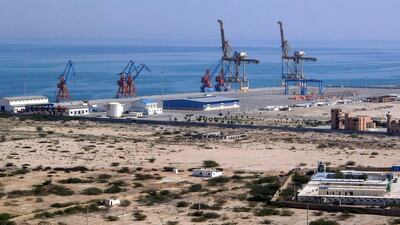China and India are locked in a global energy game that is being played out via ports in nearby nations. For China the goal is expansion. For India, avoiding encirclement by its larger neighbour.
As China develops Gwadar port in south-western Pakistan, Chabahar port in south-eastern Iran is filling India’s strategic need. And while both projects have been in the works for years, yet more years – and more hundreds of millions of dollars – will be required before the plan for either is fully realised.
Gwadar’s port has not yet undergone significant development on the infrastructure side, and is still without road and rail links with the rest of Pakistan. The port’s traffic has been restricted to bulk cargo such as wheat and urea since 2008. China, however, plans to invest US$10 billion to make the port fully functional. Last year, it also signed a deal to build an $18bn economic corridor linking Gwadar to Kashgar in China’s north-western Xinjiang province.
Also last year, India’s then-minister of external affairs, Salman Khurshid, paid a visit to Tehran and expressed hope that the upgrading of Chabahar’s port would be complete within two or more years. India also provided Iran with $136 million to aid work linking Chabahar to Afghanistan’s main road network.
In this drawn-out contest, the battle lines are the trade routes to the oil-rich Middle East and energy-rich Central Asia. The winner will be whoever gains the most secure access to these resources.
For India, Chabahar is the nearest port to the Indian Ocean providing direct access to the Middle East and Central Asia. The port is an economic gateway thanks to its location on the Gulf of Oman outside the Strait of Hormuz.
For China, Gwadar could be a terminus for pipelines in its oil and gas supply chain from Africa and the Middle East, allowing it to bypass the congested pinch point that is the Strait of Hormuz.
Presently, China imports oil from the Middle East using the Dubai-Shanghai-Urumqi route covering more than 10,000 kilometres, which would be shortened to 3,600km through the proposed Dubai-Gwadar-Urumqi route. Gwadar also brightens the prospects for a pipeline corridor bringing oil and gas to China from the Middle East.
Last year, Pakistan transferred operational control and management of Gwadar port from a Singaporean company to China Overseas Port Holdings. That made China simultaneously the port’s builder, financier and operator. The development raised eyebrows in New Delhi, which regards the Chinese presence in Gwadar as a threat to its strategic interests in the Indian Ocean. India is wary of the so-called “String of Pearls” being built by China through its neighbourhood. Besides Gwadar, China has also funded Hambantota port in Sri Lanka and Chittagong port in Bangladesh. What continuously haunts India is the idea of encirclement by China. India controls no chokepoint on the coastline of the subcontinent through which international shipping must pass.
India is developing a north-south trade corridor from Central Asia to Afghanistan through Chabahar, from where goods could be shipped by sea to India. Through the proposed corridor, India plans to establish its foothold in Central Asia to tap that region’s huge energy reserves without using the Afghanistan-Pakistan route. It is an irony of geography that India cannot have access to Afghanistan, Iran and Central Asia through land without traversing Pakistani territory. To this end, New Delhi in 2000 signed deals with Iran and Russia to develop Chabahar port and a north-south trade corridor to link India to Central Asia through Iranian ports and Afghan roads.
In economic terms, the early advantage goes to Gwadar. It seems difficult for India to take advantage of Chabahar for a long period, as the cost of doing trade through this port is much higher than possible trade through Gwadar with Central Asia and Afghanistan. The costs are higher at Chabahar simply because, having to bypass Pakistan, it is part of a longer trade route.
Still, despite higher costs, Chabahar provides India with a competitive alternative to Gwadar and poses a challenge to Pakistan in diverting some trade away from Gwadar.
Both ports face political difficulties.
The law and order situation in insurgency-hit Balochistan province, where Gwadar is located, has slowed progress on the project. Although China has not yet been able to make the port fully functional, it is taking a greater stake in developing the port. It was security concerns that China shelved a multibillion dollar oil refinery project in Gwadar in 2009.
On the other hand, the West’s policy of economically isolating Iran has raised questions about the utility of Chabahar port for India. The outcome of foreign powers’ talks with Iran regarding its nuclear ambitions will, among their many other repercussions, weigh on India’s aspirations for Chabahar.
How might this play out in the next year or two?
The answer will reflect on India’s role in the world. The US considers India as a counterweight to contain China’s growing influence. If the two ports become fully functional with all the proposed road and rail links, the competition between the two will escalate India-Pakistan rivalry on one hand and a polarisation on geopolitical lines in the region, on the other hand. It actively participated in building trans-Afghanistan road and rail links from Uzbekistan’s Termez to Chabahar.
India has already increased its diplomatic presence and is now struggling to increase its economic presence in Afghanistan. Pakistan accuses India of fuelling a separatist insurgency in its Balochistan province bordering Afghanistan – and peace in Balochistan is the key to turning Gwadar into a regional hub for the Chinese.
Syed Fazl-e-Haider is a development analyst in Pakistan. His books include The Economic Development of Balochistan.
Follow The National's Business section on Twitter

